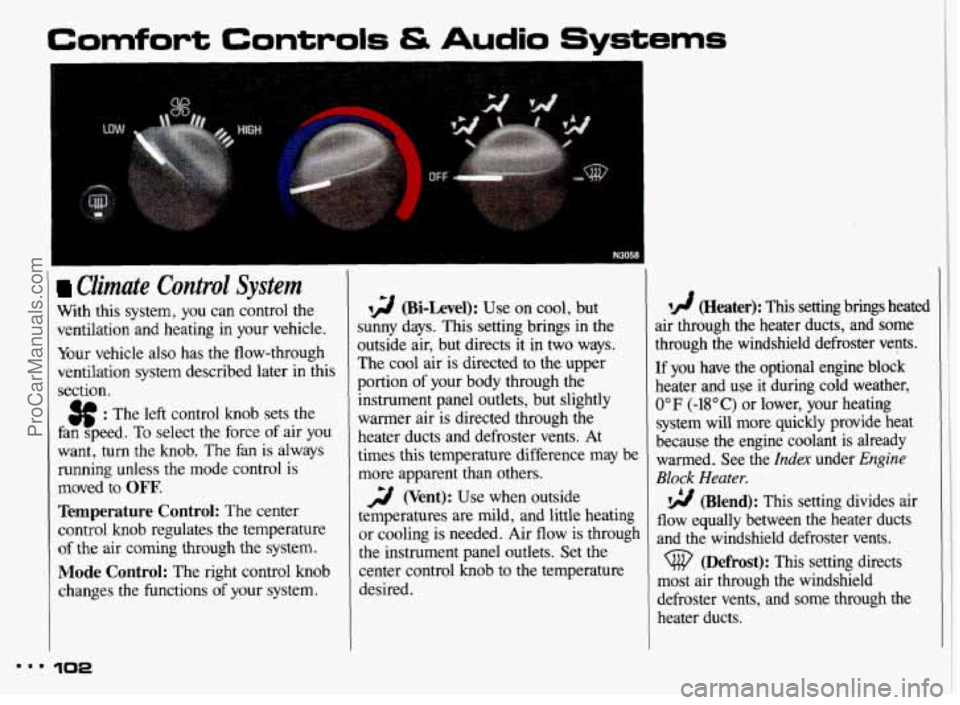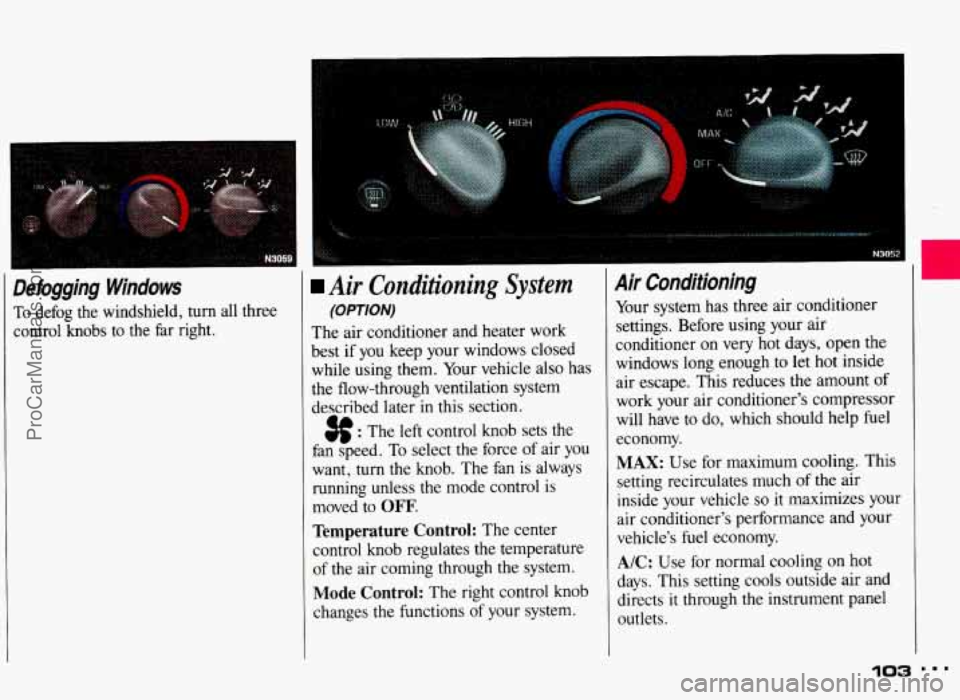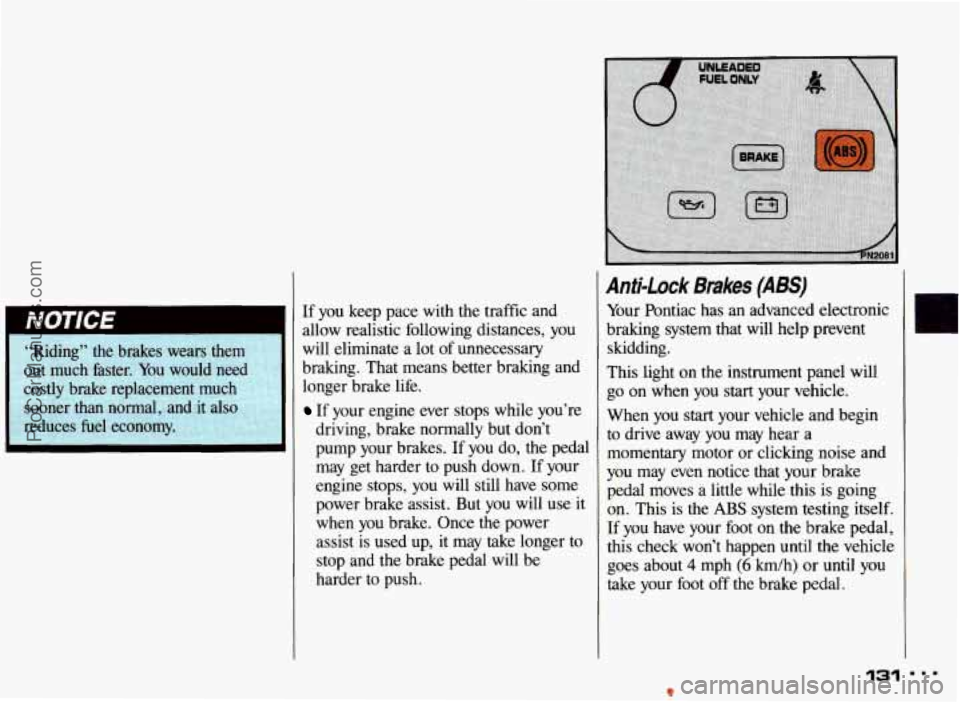Page 78 of 306
Fog Lights
The switch for your fog lights is next to
the instrument panel intensity control. Push the top of the switch to
turn the fog
lights on.
When using fog lights, the parking lights
or low beam headlights must be on.
Fog lights will go off whenever the high
beam headlights come on. When the
high beams go off, the fog lights will
come on again.
N2158 1
Front Reading Lights (omorv)
These lights and the interior courtesy
lights will come
on when you open the
doors.
To turn on
a reading light when the
doors are closed, press the button. Press
it again to
turn the light off.
Rear Reading Lights (omorv)
These overhead lights and the interior
courtesy lights will come
on when you
open the doors.
To turn on a reading light when the
doors are closed, press the button. Press
it again to
turn off the light.
ProCarManuals.com
Page 85 of 306
FE 'tures & Controls
t-- .
-
Passenger Side Cup Holder/ Storage Area
To access the cup holder and storage
area, slide your finger in the groove and
press
in on the button located in the
upper left corner of the instrument panel
on the passenger side. Then pull the cup
holder forward and down.
To close the
cup holder/storage area, push the cup
holder up and to the left until
it latches.
34
Garment Hook
Push down on the tab marked i to
fold down the garment hook.
Coin Holder
Place your coins in the appropriate slots.
ProCarManuals.com
Page 88 of 306
The lnstrument Panel-
bur Information System
Your instrument panel is designed to let
you know at a glance how your vehicle
is running. You’ll know how fast you’re going, how much fuel you’re using, and
many other things you’ll need to drive
safely and economically.
The main components
of your
instrument panel are:
1. Fog Light Switch
2. Instrument Panel Intensity
3. Side Vent
4. Turn SignaUHeadlight Beam Lever Control/Interior Lights Switch
5. Hazard Warning Flashers Switch
6. Instrument
Cluster
7. Windshield Wiper/Washer Stalk
8. Center Vent
9. Audio System
1 0. Side Vent
1 1. Side Window Defogger Vent
12. Glove Box
1 3. Climate Control System
14. Ashtray/Lighter
15. Gear Shift Lever
16. Rear Window Defogger (Option)
17. Ignition Switch
18. Horn
1 9. Tilt Steering Wheel Lever (Option)
20. Parking Brake Release Lever
21. Hood Release Handle
22. Fuse Panel
I
ProCarManuals.com
Page 89 of 306
Features & Controls
Instrument Panel Clusters
Your Pontiac is equipped with one of these instrument panel clusters, which
includes indicator warning lights and gages that are explained on the following
pages. Be sure to read about those that apply to the instrument panel cluster\
for
your vehicle.
Standard Cluster
N2191
ProCarManuals.com
Page 103 of 306

Comfort Controls & Audio Systems
Climate Control System
With this system, you can control the
ventilation and heating in your vehicle.
Your vehicle also has the flow-through
ventilation system described later in this
section.
$$ : The left control knob sets the
fan speed.
To select the force of air you
want, turn the knob. The fan
is always
running unless the mode control
is
moved to OFF’.
Temperature Control: The center
control knob regulates the temperature
of the air coming through the system.
Mode Control: The right control knob
changes the functions
of your system.
N3058
12 (Bi-Level): Use on cool, but
;unny days. This setting brings in the
3utside air, but directs it in two ways.
rhe cool air is directed to the upper
2ortion
of your body through the
instrument panel outlets, but slightly
warmer air
is directed through the
heater ducts and defroster vents. At
times this temperature difference may be
more apparent than others.
temperatures are mild, and little heating
or cooling is needed. Air flow is through
the instrument panel outlets. Set the
center control
knob to the temperature
desired.
2 (Vent): Use when outside
lA (Heater): This setting brings heated
air through the heater ducts, and some
through the windshield defroster vents.
[f you have the optional engine block
heater and use it during cold weather,
0°F (-18°C) or lower, your heating
system will more quickly provide heat
because the engine coolant is already
warmed. See the
Index under Engine
Block Heater.
flow equally between the heater ducts
and the windshield defroster vents.
most air through the windshield
defroster vents, and some through the
heater ducts.
(Blend): This setting divides air
(Defrost): This setting directs
m.. 102
ProCarManuals.com
Page 104 of 306

Defogging Windows
To defog the windshield, turn all three
control knobs to the far right.
I
I
Air Conditioning System
(OPTION)
The air conditioner and heater work
best if you keep your windows closed
while using them. Your vehicle also has
the flow-through ventilation system
described later
in this section.
3f : The left control knob sets the
fan speed. To select the force
of air you
want,
turn the knob. The fan is always
running unless the mode control is
moved to
OFF.
Temperature Control: The center
control knob regulates the temperature
of the air coming through the system.
Mode Control: The right control knob
changes the functions
of your system.
Air Conditioning
Your system has three air conditioner
settings. Before using your air
conditioner on very hot days, open the
windows long enough
to let hot inside
air escape. This reduces the amount
of
work your air conditioner's compressor
will have to do, which should help fuel
economy.
MAX: Use for maximum cooling. This
setting recirculates much
of the air
inside your vehicle
so it maximizes your
air conditioner's performance and your
vehicle's fuel economy.
A/C: Use for normal cooling on hot
days. This setting cools outside air and
directs it through the instrument panel
outlets.
103
ProCarManuals.com
Page 105 of 306

Comfort Controls & Audio Systems
Air Conditionina (CONI) -.
qg (Bi-Level): Use on cool, but
sunny days. This setting brings in the
outside air, but directs it in two ways.
The cool air is directed to the upper
portion of your body through the
instrument panel outlets, but slightly
warmer air is directed through the
heater ducts and defroster vents. At
times this temperature difference may be
more apparent than others.
The air conditioner compressor operates
in all three air conditioning positions. It
also operates in (Defrost) when
the outside temperature is higher than
about
40°F (4.5"C).
Ventilation
Use when outside temperatures are
mild, and little heating or cooling is
needed. Turn the right control knob to
2 (Vent). Air flow is directed
through the instrument panel outlets. Set
the center control knob to the
temperature desired.
Heating
Turning the right control knob to
72 (Heater) and the center control
knob clockwise will send heated air
through the heater ducts, and some
through the defroster vents.
3 (Vent) and (Heater) are
economical positions because the air
conditioner compressor doesn't run in
these two settings. This reduces engine
load, resulting in improved fuel
economy. If either setting fails to keep you
comfortable, or causes your windows
to fog up, turn the right control knob to
one of the air conditioning positions, or
to
(j@ (Defrost).
If you have the optional engine block
heater and use it during cold weather,
0°F (-18°C) or lower, your heating
system will more quickly provide heat
because the engine coolant is already
warmed. See the
Index under Engine
Block Heater.
flow equally between the heater ducts
and the windshield defroster vents.
vg (Blend): This setting divides air
Defrosting
The (@ (Defrost) setting directs most
air through the defroster vents, and
some through the heater ducts.
8.8 104
ProCarManuals.com
Page 132 of 306

“Riding” the brakes wears them
out much faster. You would need
costly brake replacement
much
sooner than normal, and it also reduces fuel economy. If you keep pace with the traffic and
allow realistic following distances,
you
will eliminate a lot of unnecessary
braking. That means better braking and
longer brake life. If your engine ever stops while you’re
driving, brake normally but don’t
pump your brakes. If you do, the pedal
may get harder to push down. If your
engine stops, you will still have some
power brake assist. But
you will use it
when you brake. Once the power
assist is used up, it may take longer
to
stop and the brake pedal will be
harder to push.
Anti-Lock Bmkes (ABS)
Your Pontiac has an advanced electronic
braking system that will help prevent
skidding.
This light on the instrument panel will
go on when you start your vehicle.
When you
start your vehicle and begin
to drive away you may hear a
momentary motor or clicking noise
and
you may even notice that your brake
pedal moves a little while this is going
on. This is the ABS system testing itself.
If you have your foot on the brake
pedal,
this check won’t happen until the vehicle
goes about
4 mph (6 km/h) or until you
take your foot off the brake pedal.
131
ProCarManuals.com